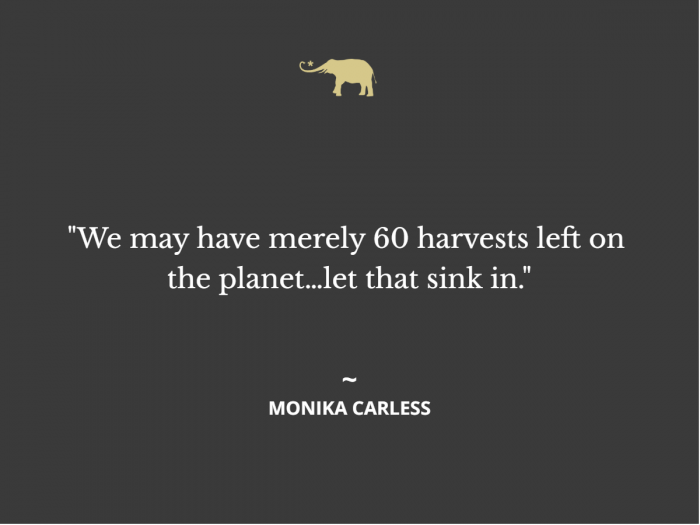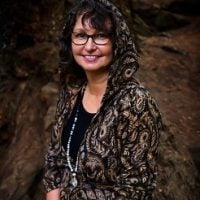I live on Bear Mountain, on the south-western tip of Vancouver Island, Canada.
It is the traditional and unceded land of the Lkwungen People, where for centuries, hereditary leaders, matriarchs, their ancestors, and creatures of the land and sea, have stewarded rich, visible, and invisible resources.
It is the land of rolling mists, bears, deer, and cougars, and I am fortunate to see ravens and eagles circling nearby Mount Finlayson every single day.
Bear Mountain is also a resort community. There are two golf courses, a hotel, forest trails for hikers, and mountain bikers, where one side of the mountain was developed for housing roughly fifteen years ago, amid much protest from the First Nations community.
When we moved to the West Coast five years ago, it was a natural place for us to settle, in close proximity to the city where my partner works, and a place where I could practice my witchcraft among the relative wilderness. Immediately, being sensitive to the invisible, I heard the cries of the land.
Although much good effort went into replanting the landscape after development, one cannot ignore the facts of what was taken down first.
When you sit at the crossroads of being committed to preserving and nurturing the natural world, yet have the footprint of the colonizer, you quickly realize the hypocrisy and dilemma of being part of the problem.
Recently, the other half of Bear Mountain was clear cut by my municipality for housing, with not one tree left, not even our Garry Oak or Arbutus trees, rare and native to mainly this part of the world. The city of Langford has recently been named the most livable city in Canada…not for the deer or trees, also sentient beings. My community does not have any tree protection bylaws somehow. (Insert every sad and angry emoji here.)
I watch the deer walk around in confoundment. My heart is wrenched by habitat loss. This is not happening somewhere else in some vague reality I only read about, this is at my doorstep, impossible to ignore. Sometimes, when we contemplate the environmental ecocide, it does seem remote, easy to intellectualize or debate. But when we see it in such a visceral way, it leaves the realm of theory with great speed.
This past winter, I stocked up on documentary-watching. Some of the most notable ones were David Attenborough’s “A Life on Our Planet,” “Kiss the Ground,” narrated by Woody Harrelson, and “Rotten,” a docu-series on Netflix.
Tears flowed like rivers as I sat on my comfortable couch, clutching onto the hope that they would end with some positive ways I could make a difference.
It is a sobering thought to know how much of the earth’s biodiversity and soil has been lost in the last 80 years, specifically. It’s actually so difficult to imagine that the mind wishes to turn away from the reality of it. To hear that we may have merely 60 harvests left on the planet…let that sink in…quickly shifts perspective.
I think of my one-year-old granddaughter and the children coming into this world. A healthy world is the only intrinsically valuable thing we can leave them.
Despite my angst, I do believe in sustainable solutions. I believe in the ability of humanity to “give a care” and to put that into action. I believe that more and more of us understand sentience as something far beyond humans and animals, stretching to plants, trees, and the planet herself.
Twenty years or so ago, I began community work towards local sustainability. When you live on the land, grow your own food, the seasons, cycles of life, the earth in your garden, and the water in the ground become holy. You become attuned to these life forces, and either care or don’t, either live in harmony with what sustains you or you simply take it all.
What can I do to contribute to environmental restoration, sustainability, and to local resilience?
I’m going Beyond Vegan to support my Mother, Earth.
I’m not suggesting that veganism isn’t one solution in any way. Rather, I am asking what more can we do—because there isn’t just one system out there that addresses all the environmental, health, and ethical issues we face.
Beyond Veganism is different things to different people.
For instance, one person I know hunts all his meat, as his contribution to the environment. I know… sounds like a contradiction doesn’t it? Here is his commitment: He doesn’t buy inhumanely treated animals wrapped in plastic at the grocer. He does a ceremony before he harvests. He uses every single part of the animal. He will never be vegan, for a variety of reasons, but has a heart for the planet, and supports his local farmers for veg and fruit. Is this environmental activism? You bet. It’s one way.
Here are some other ways to think big picture and try Beyond Veganism.
Eat Local, Eat Seasonal, Eat Homegrown.
The relative affluence (relative to race, government, and location) born post World War II, meant that we could eat food from anywhere, anytime, sprayed with any amount of deadly chemicals left over from the war effort. We could give up our agency and will to grow food for ourselves. We could rely on fruit and vegetables grown in faraway places, by grossly underpaid and undervalued farmworkers.
When we eat local and/or homegrown, we strengthen our local economic and environmental resiliency. It is a revolutionary act these days to be responsible for our own sustenance or to support those close by who are willing to grow for us.
When we eat seasonally, we are supporting our bodies and psyches in ways that they inherently understand. Grounding foods in the winter, cleansing foods in the spring, light and nourishing in the summer, warming in the fall.
We are not meant to eat everything in every season. The cost of this desire is the heavy impact of fossil fuels to cart our food around the world. There will simply come a day when we can no longer do this, and if we have not built local resiliency, we will be hungry. I cannot say that I am eating a complete 100-mile diet, but am in transition and making more conscious choices.
Eat with Awareness and Gratitude.
Cows and chickens are not the only animals for whom massive amounts of grains are grown, or why topsoil is at critically low levels. Humans are that other voracious animal to consume them plus corn, pulses, and legumes.
So when we think of soil erosion, of desertification, which is happening in Africa, California, Australia, Latin America, and Europe at alarming rates, it cannot be with any kind of smugness that we’re not contributing. This issue sits on all our plates. Deforestation happens to support all animals. Soil erosion happens because of all humans.
Let us question what the costs of avocado and water wars truly are. Let us look with inquiring minds, be brave in assessing the answers, and find where our responsibility lies. Together, we can come up with brilliant solutions to the world’s most pressing hunger, environmental, and equity issues.
Let us poke where it is painful to look and ask ourselves, “Where does my piece of the puzzle lie?”
Eating responsibly means different things to different people.
We must have this conversation in kindness and compassion. Imagine if we all tried our best to do what we could, and found solutions together.
Think of Community Instead of Self-Sufficiency.
This past year, COVID has brought the true (and largely forgotten) value of community front and center. There’s been this huge buzz around self-sufficiency for years. Having lived on a small homestead where we grew a lot of our own veg, I can tell you that there is no such thing as true self-sufficiency anyway, but we may achieve a relative status of this.
In the free world, we are obsessed with the individual. We don’t value common good and public interest as they are valued in other places where it is imperative for the community to be supported in order for the individual to thrive.
I’ve lived in a communist country, and the cries of communism over COVID restrictions just make me roll my eyes. Common good and care for each other is not communism (when you truly understand it); it’s a sustainable future.
When we think of community sufficiency, we are embarking on generosity, compassion, kindness, wide-spectrum solutions. It builds relationships and creates a matrix of strength in local and global initiatives.
If you Eat Meat—Source Locally-Farmed (where possible), Grass-Fed, Pastured, Humanely-Raised.
I’m speaking in a few sentences about an extremely complex and divisive issue. We may not be able, or it even be advisable according to our own needs, to be vegan or vegetarian. All we can do is our best in addressing the moral and environmental costs of being omnivores.
Grass-fed herds are one solution to maintaining topsoil, pounding nutrients into it with their hooves, living life in natural surroundings without relying on grain inputs. The place where all philosophies can find soulful agreement is that the way we have treated animals and the soil must end. And not only because we need to survive as a species, but as a way to honor all other life forms.
Plant Heritage, Open-Pollinated Seeds.
Biodiversity is shrinking. Economy is not only measured in dollars but in the variety of life on the planet. We will literally starve ourselves, the bees, the atmosphere if we keep dwindling our seed bank.
Luckily, we can do something powerful, by planting vegetable varieties that have long vanished from store shelves. We are an incredibly resilient and resourceful species, and though much has been lost, our desire to restore is absolute magic.
And so, with the sun warming my garden beds, Spring Equinox on the horizon, and life literally bursting forth, I’m convinced that we can learn from ancient and recent history, and be the change. Let’s do this!
Blessed Equinox, wherever you may be.
 Share on bsky
Share on bsky






Read 20 comments and reply